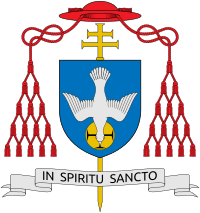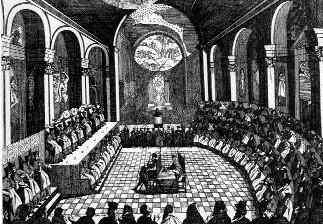Leo Joseph Suenens
Leo Jozef Suenens (/ˈsuːnɛns/ SOO-nens) (16 July 1904 – 6 May 1996) was a Belgian prelate of the Roman Catholic Church. He served as Archbishop of Mechelen-Brussel from 1961 to 1979, and was elevated to the cardinalate in 1962.
Leo Jozef Suenens | |
|---|---|
| Cardinal, Archbishop of Mechelen-Brussel Primate of Belgium | |
 | |
| See | Mechelen-Brussel |
| Installed | 24 November 1961 |
| Term ended | 4 October 1979 |
| Predecessor | Jozef-Ernest van Roey |
| Successor | Godfried Danneels |
| Other posts | Auxiliary Bishop of Mechelen (1945–61) |
| Orders | |
| Ordination | 4 September 1927 |
| Consecration | 16 December 1945 by Jozef-Ernest van Roey |
| Created cardinal | 19 March 1962 |
| Personal details | |
| Born | 16 July 1904 Ixelles, Kingdom of Belgium |
| Died | 6 May 1996 (aged 91) Brussels, Kingdom of Belgium |
Suenens was a leading voice at the Second Vatican Council and advocated aggiornamento in the Church.
Biography
Early life and education
Leo Suenens was born at Ixelles, the only child of Jean-Baptiste and Jeanne (née Jannsens) Suenens. He was baptised by his uncle, who was also a priest. Losing his father (who had owned a restaurant)[1] at age four, Leo lived with his mother in the rectory of his priest-uncle from 1911 to 1912. Wealthy relatives wanted him to study economics and manage their fortune, but he chose the priesthood. He studied at Saint Mary's Institute in Schaerbeek and then entered the Pontifical Gregorian University in Rome in 1920. From the Gregorian he obtained a doctorate in theology and in philosophy (1927), and a master's degree in canon law (1929). Suenens had taken as his mentor Cardinal Désiré-Joseph Mercier, who had also sent him to Rome.
Priesthood
Ordained to the priesthood on 4 September 1927 by Cardinal Jozef-Ernest van Roey, Suenens initially served as a professor at Saint Mary's Institute and then taught moral philosophy and pedagogy at the Minor Seminary of Mechelen from 1930 to 1940. He worked as a chaplain to the 9th artillery regiment of the Belgian Army in Southern France for three months, and in August 1940 he became vice-rector of the famed Catholic University of Louvain. When the Louvain's rector was arrested by Nazi forces in 1943, Suenens took over as acting rector, where he sometimes circumvented and sometimes openly defied the directives of the Nazi occupiers.[2] Raised to the rank of Monsignor in October 1941, he was included on a list of thirty hostages who were to be executed by the Nazis, but the Allied liberation of Belgium occurred shortly before these orders could be carried out.
Episcopal career
Ordination history of Leo-Joseph Suenens | |||||||||||||||||||||||
|---|---|---|---|---|---|---|---|---|---|---|---|---|---|---|---|---|---|---|---|---|---|---|---|
| |||||||||||||||||||||||
| |||||||||||||||||||||||
| Styles of Leo Jozef Suenens | |
|---|---|
 | |
| Reference style | His Eminence |
| Spoken style | Your Eminence |
| Informal style | Cardinal |
| See | Mechelen-Brussel |
On 12 November 1945, he was appointed by Pope Pius XII as Auxiliary Bishop of Mechelen and Titular Bishop of Isinda. Suenens received his episcopal consecration on the following 16 December from Cardinal van Roey, with Bishops Étienne Joseph Carton de Wiart and Jan van Cauwenbergh serving as co-consecrators. He was named Archbishop of Mechelen on 24 November 1961; the primatial Belgian see was renamed Mechelen-Brussel on 8 December of the same year. Suenens was created Cardinal Priest of S. Pietro in Vincoli by Pope John XXIII in the consistory of 19 March 1962.[2]
Suenens was one of the cardinal electors who participated in the 1963 papal conclave which selected Pope Paul VI.
He also voted in the conclaves of August and October 1978, and finally resigned from his post in Mechelen-Brussel on 4 October 1979 after seventeen years of service.
Second Vatican Council
When Pope John called the world's bishops to Rome for the Second Vatican Council (1962–1965), he found in Suenens a man who shared his views on the need for renewal in the Church. When the first session fell into organizational chaos under the weight of its documents, it was Suenens who, at the invitation of the Pope, rescued it from deadlock and essentially set the agenda for the entire Council.
Paul VI made him one of the four moderators of the Council, along with Cardinals Gregorio Pietro Agagianian, Julius Döpfner, and Giacomo Lercaro. Suenens was also believed to be a decisive force behind the Conciliar documents Lumen gentium and Gaudium et spes.
Death
Suenens died from thrombosis in Brussels at age 91,[3] and was buried at St. Rumbolds Cathedral. At the time of his death he was one of the four living Cardinals elevated by Pope John XXIII.
After his death, Belgian police drilled into his tomb and that of Cardinal Jozef-Ernest Van Roey, searching for documents connected to the sex abuse scandal, which had supposedly been buried with the cardinals.[4]
Views
Reforms
After the Council, Suenens committed himself to implementing its reforms, although not without controversy.
Dialogue with the modern world
Dialogue with other Christian denominations as well as with other religions, the proper role of the laity, modernization of religious life for women,[5] collegiality,[6][7] religious liberty, collaboration and corresponsibility in the Church were among the causes he advocated at the Council.
His successor, Godfried Danneels, described him as an excellent weather-forecaster who knew from which direction the wind was blowing in the Church, and an experienced strategist who realized that he could not change the wind's direction but could set the sails to suit it. Pope John Paul II himself later attested that "Cardinal Suenens had played a decisive part in the Council".[8]
Relations with the Curia
In May 1969, an interview he gave to the French Catholic magazine Informations Catholiques Internationales in which he offered a passionate critique of the Roman Curia.[1] Eugène-Gabriel-Gervais-Laurent Tisserant subsequently demanded a retraction, but Suenens refused and declared that Tisserant's reaction as unacceptable and unfounded.[1] Ten years later, he reflected on the event and said, "There are times when loyalty demands more than keeping in step with an old piece of music. As far as I am concerned loyalty is a different kind of love. And this demands that we accept responsibility for the whole and serve the Church with as much courage and candor as possible."
Ecumenism
Committed to ecumenism, he and Archbishop Michael Ramsey of Canterbury were close friends.[9]
Marriage
During the Council's debates on marriage, Suenens accused the Church of holding procreation above conjugal love;[10] Pope Paul was greatly distressed by this and the Cardinal later denied "that he had questioned the authentic Church teaching on marriage".[11]
Humanae Vitae
According to Time Magazine, Suenens counseled the Pope against the releasing of his Encyclical Letter Humanae Vitae.[12]
Orthodoxy and heterodoxy
Suenens once remarked, "If you don't believe in the Holy Spirit or Resurrection or life after death, you should leave the Church."[1]
Charismatic Renewal
He endorsed the Catholic Charismatic Renewal;[13][14] his episcopal motto was In Spiritu Sancto ("In the Holy Spirit").
Trivia
| Part of a series on |
| Ecumenical councils of the Catholic Church |
|---|
 Renaissance depiction of the Council of Trent |
| Antiquity (c. 50 – 451) |
| Early Middle Ages (553–870) |
| High and Late Middle Ages (1122–1517) |
| Modernity (1545–1965) |
|
|
- During his studies at Rome, Suenens resided at the Belgian Pontifical College and also served as college librarian.
- The Cardinal also served as National President of the Legion of Mary and Pax Christi, national liaison for Catholic Action in Belgium,[15] and later President of the Belgian Episcopal Conference.[16]
- In 1976 he received the Templeton Prize for Progress in Religion.
- During the August 1978 conclave, Suenens thanked Pope John Paul I for accepting his election[17]
See also
- Archbishopric of Mechelen-Brussel
References
- "Roman Catholics: The Cardinal as Critic". TIME. 1 August 1969. Retrieved 21 July 2014.
- Steinfels, Peter. "Leo Joseph Cardinal Suenens, A Vatican II Leader, Dies at 91", The New York Times, 7 May 1996
- "Archived copy". Archived from the original on 28 September 2007. Retrieved 13 April 2007.CS1 maint: archived copy as title (link)
- "Police 'Sex Abuse Cover Up' Raid on Belgian Cardinals' Tombs Slammed by Vatican". MedIndia. 7 June 2010. Retrieved 21 June 2015.
- "The Vatican Council: A Mind of Its Own". TIME. 20 November 1964. Retrieved 21 July 2014.
- "Roman Catholics: Council on the Move". TIME. 8 November 1963. Retrieved 21 July 2014.
- "Roman Catholics: The Prelates Speak Out". TIME. 24 October 1969. Retrieved 21 July 2014.
- Archived 14 December 2006 at the Wayback Machine
- "Compass Vol. 14 #3, Schaper and Catoir Articles". Gvanv.com. Archived from the original on 17 January 2016. Retrieved 21 July 2014.
- "Roman Catholics: No More Galileos". TIME. 6 November 1964. Retrieved 21 July 2014.
- http://www.ewtn.com/library/SCRIPTUR/MARRIAGE.TXT
- "Religion: Birth Control: Pronouncement Withdrawn". TIME. 21 June 1968. Retrieved 21 July 2014.
- "Religion: The Pentecostal Tide". TIME. 18 June 1973. Retrieved 21 July 2014.
- "What is the Nature of the Catholic Charismatic Renewal?". Ccr.org.uk. 19 September 2003. Archived from the original on 4 October 2012. Retrieved 21 July 2014.
- "Leo Jozef Cardinal Suenens - 1904-1996". ICCRS Newsletter. 1996. Archived from the original on 28 September 2007.
- "The Cardinals of the Holy Roman Church - Biographies - S". Fiu.edu. Retrieved 21 July 2014.
- "Religion: How Pope John Paul I Won". TIME. 11 September 1978. Retrieved 21 July 2014.
External links
| Wikimedia Commons has media related to Leo Joseph Suenens. |
- Suenens Centre
- Suenens' Speech to the Legion of Mary in Liverpool
- Cardinals of the Holy Roman Church
- Catholic-Hierarchy [self-published]
| Catholic Church titles | ||
|---|---|---|
| Preceded by Jozef-Ernest van Roey |
1st Archbishop of Mechelen-Brussel 1961–1979 |
Succeeded by Godfried Danneels |
| Preceded by Teodósio de Gouveia |
Cardinal-Priest of the San Pietro in Vincoli 1962–1996 |
Succeeded by Jean Marie Balland |